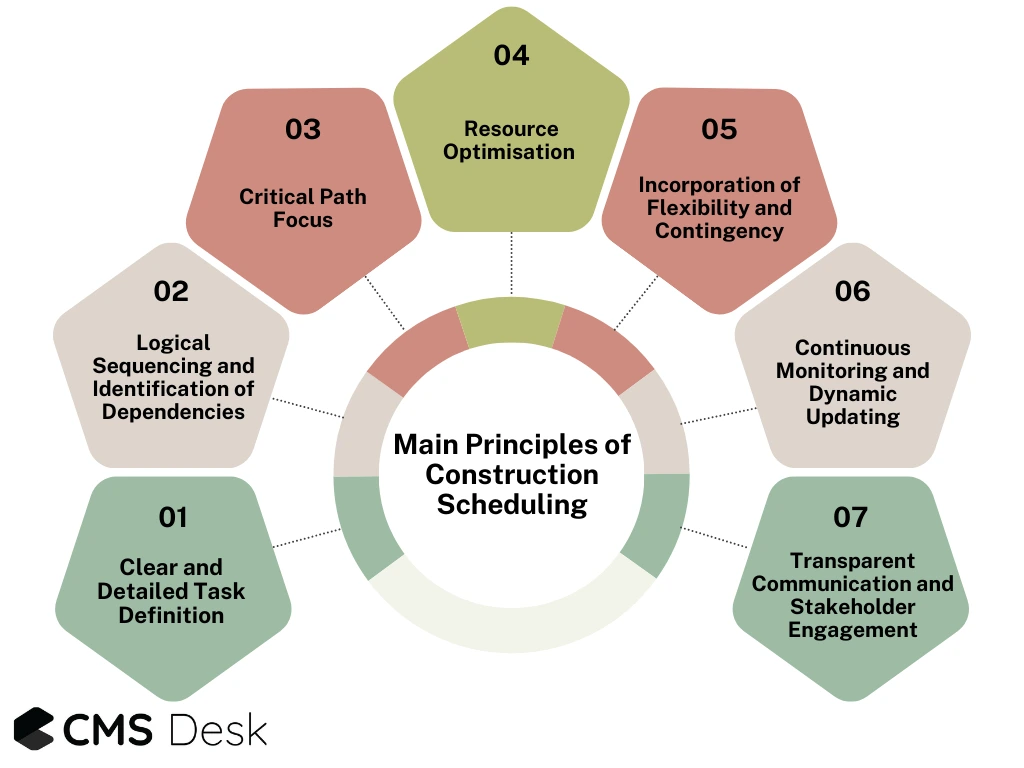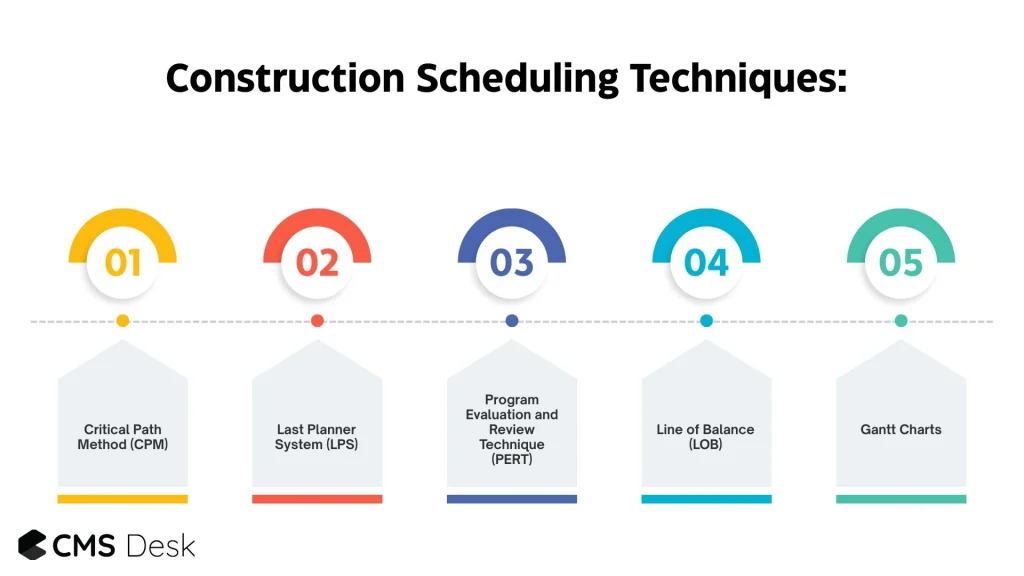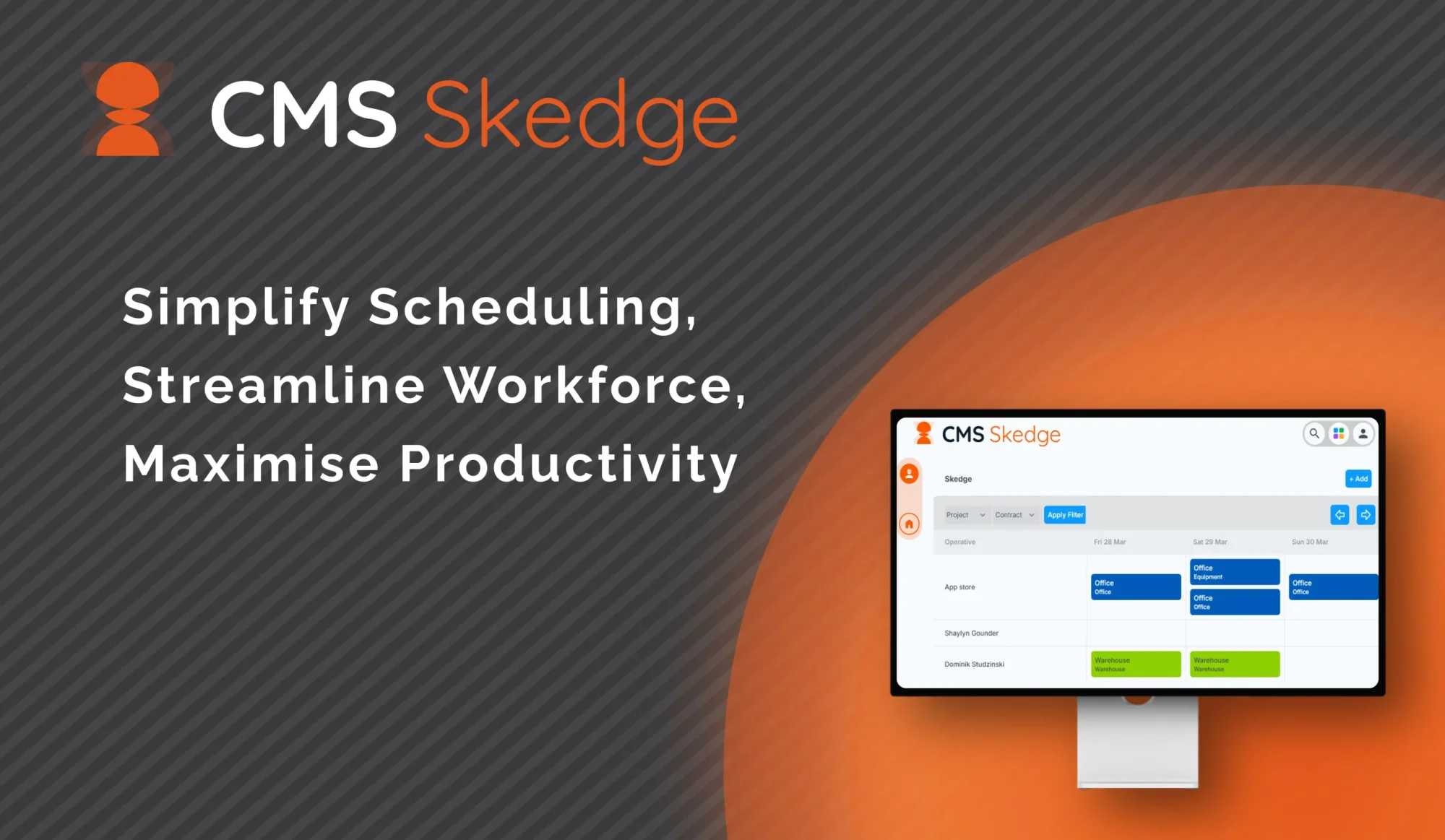
Construction scheduling is a critical project management process that involves creating a detailed timeline for all tasks and activities required to complete a construction project successfully. It maps out what needs to be done, by whom, and when, ensuring that resources such as labor, materials, and equipment are allocated efficiently throughout the project lifecycle. Construction scheduling provides a structured roadmap that guides the project team, allowing them to monitor progress, anticipate challenges, and adjust plans to maintain deadlines and budgets. In an industry where delays can be costly and disruptive, a well-prepared schedule is fundamental to delivering projects on time and within scope. Construction scheduling is also a vital part of construction management. This process is not only about sequencing tasks but also about managing dependencies, identifying critical milestones, and balancing resource availability to streamline workflows.
What Is a Construction Scheduler?
A construction scheduler is a project management professional responsible for developing, maintaining, and updating the construction schedule. They work closely with project managers, contractors, subcontractors and HR in construction companies to ensure the schedule reflects the realities of the construction site. Their role involves analysing project plans, breaking down work into manageable tasks, estimating durations, and identifying task dependencies. Beyond planning, the construction scheduler monitors progress and adjusts the timeline to accommodate delays, resource constraints, or scope changes. They serve as the communication bridge among stakeholders by providing accurate and timely schedule updates that inform decision-making. Effective schedulers possess a strong understanding of construction processes, critical path methods, and software tools that support schedule visualisation and tracking. Their expertise helps mitigate risks, prevent bottlenecks, and ensure smoother project delivery.
Why Is Construction Scheduling Important?
The importance of construction scheduling lies in the structure, clarity, and control it provides to the entire project lifecycle. By sequencing tasks logically and aligning resources effectively, scheduling reduces downtime, prevents costly delays, and promotes coordination across multiple contractors and trades. Construction scheduling is vital for maintaining budget discipline by identifying potential overruns early, much like effective construction budget tracking. A well-prepared schedule promotes transparency and accountability, giving all stakeholders a shared understanding of responsibilities, deliverables, and deadlines.
Together, the discipline of scheduling and the expertise of the scheduler provide the framework through which construction projects can be delivered on time, within budget, and to the expected quality standards.
Main Principles of Construction Scheduling
Construction scheduling is a complex discipline that demands careful attention to foundational principles to ensure that a project is delivered on time, within budget, and to the required quality standards. These guiding principles are essential for developing a schedule that is not only detailed and logical but also flexible and responsive to the inevitable changes that occur during construction. Below are the core principles that underpin effective construction scheduling:
1. Clear and Detailed Task Definition
Every construction activity included in the schedule must be clearly defined with explicit descriptions of the work involved. Ambiguous or vague task definitions can lead to misunderstandings, incorrect resource allocations, or delays. For example, instead of simply listing “foundation work,” the task should be broken down into subtasks such as excavation, formwork, reinforcement placement, and concrete pouring. This level of detail enables precise time estimation, better resource planning, and easier monitoring of progress. Moreover, clear task definitions improve communication among contractors, subcontractors, and suppliers, ensuring everyone understands exactly what is expected and when.
2. Logical Sequencing and Identification of Dependencies
Tasks within the schedule must be arranged in a sequence that reflects real-world constraints and project logic. Construction work typically follows a specific order where certain activities cannot begin until others are completed—for instance, electrical wiring cannot start until the framing is finished. Identifying these dependencies—such as finish-to-start, start-to-start, or finish-to-finish relationships—is crucial to avoid scheduling conflicts and ensure smooth workflow. Proper sequencing helps prevent resource clashes and bottlenecks, optimises task overlap where possible, and allows project managers to visualise the flow of work and identify critical junctures requiring close supervision.
3. Critical Path Focus
The concept of the critical path is central to construction scheduling. The critical path represents the longest chain of dependent activities that directly affect the project completion date. Any delay on a task along this path will delay the entire project. Recognising and managing the critical path allows project managers to prioritise resources and attention to these high-impact activities, ensuring that potential delays are anticipated and mitigated. This principle also guides decision-making on where schedule compression techniques such as crashing or fast-tracking may be employed most effectively.
4. Resource Optimisation
An efficient schedule balances the demand for resources—labour, equipment, and materials—with their availability. Resource optimisation ensures that workers are neither overbooked nor underutilised, machinery is scheduled for maximum productivity, and materials are delivered just-in-time to reduce storage costs and avoid site clutter. Resource levelling, a technique often applied during scheduling, adjusts task timings to prevent overallocation or conflicts. By optimising resource use, the schedule minimises downtime, avoids costly overtime, and maintains steady progress, all of which contribute to cost control and workforce morale.
5. Incorporation of Flexibility and Contingency
Construction projects rarely unfold exactly as planned. Weather delays, unforeseen site conditions, or supplier issues can disrupt schedules. To accommodate such uncertainties, schedules must incorporate buffers and contingency allowances. These can be built in as float time for non-critical tasks or as explicit contingency reserves that provide the project team with flexibility to absorb delays without impacting overall deadlines. A schedule that is too rigid risks cascading delays from minor setbacks, while a flexible schedule improves resilience and keeps the project on track despite disruptions.
6. Continuous Monitoring and Dynamic Updating
A construction schedule is a living document, not a static plan set at project outset. Continuous monitoring of progress against the schedule allows project managers to identify deviations early, analyse causes, and take corrective action. Regular updates—often weekly or biweekly—reflect actual progress, changes in resource availability, or scope adjustments. This dynamic management helps avoid surprises, facilitates informed communication with stakeholders, and supports proactive problem-solving. Timely schedule revisions ensure the project remains aligned with evolving realities and maintains momentum toward completion.
7. Transparent Communication and Stakeholder Engagement
Finally, effective scheduling depends on clear communication and collaboration among all project stakeholders, including owners, contractors, subcontractors, suppliers, and regulatory bodies. A transparent schedule that is accessible and understandable to all parties fosters shared responsibility and accountability. Stakeholder engagement during schedule development and updates encourages buy-in and facilitates coordination of activities, especially when multiple teams or trades are involved. Open communication channels also help resolve conflicts, clarify expectations, and ensure that everyone is working towards common milestones and deadlines.
Together, these principles provide a framework for constructing robust, realistic, and adaptable schedules that drive successful construction project delivery. By adhering to them, project teams can improve predictability, manage risk effectively, and optimise resources—ultimately ensuring projects are completed on time and to the highest standards.

Construction Scheduling Techniques: Navigating the Path to Project Success
Construction projects vary widely in size, complexity, and requirements, which means there is no one-size-fits-all approach to scheduling. To effectively plan, manage, and control construction activities, project managers rely on a variety of scheduling methodologies and techniques. Each method offers distinct advantages, addressing different project needs such as risk management, collaboration, repetitive work, or task dependencies. Understanding these techniques allows project teams to select and tailor the best approach for their specific project challenges.
Below are some of the most widely used construction scheduling techniques, along with detailed explanations of how they work, their benefits, and their appropriate applications:
1. Critical Path Method (CPM)
The Critical Path Method is one of the foundational and most commonly used scheduling techniques in construction. CPM focuses on identifying the longest sequence of dependent tasks, known as the “critical path,” which determines the shortest possible project duration. Tasks on this path have zero float, meaning any delay directly affects the overall project completion date. CPM involves detailed task identification, duration estimation, and dependency mapping to create a network diagram that visually represents task sequences.
Advantages:
- Provides a clear, visual representation of the project timeline and critical activities.
- Allows project managers to prioritise tasks that impact the overall schedule.
- Facilitates efficient allocation of resources to critical activities.
Ideal for:
Projects with well-defined tasks and dependencies where understanding the overall timeline is crucial. CPM works well for medium to large projects with complex interdependencies.
2. Last Planner System (LPS)
Rooted in lean construction principles, the Last Planner System emphasises collaboration and commitment among frontline workers, or “last planners,” who execute the construction tasks. Rather than a top-down push of schedules, LPS promotes a pull-based, commitment-driven approach where workers plan what they will realistically complete within a set timeframe, usually weekly.
Advantages:
- Enhances team communication and ownership of tasks.
- Improves the reliability of schedules by basing plans on actual readiness.
- Reduces waste and rework by identifying constraints early.
Ideal for:
Complex projects with multiple stakeholders and interdependent tasks, where team engagement and flexibility improve schedule reliability. LPS is often used in infrastructure and large commercial developments.
3. Program Evaluation and Review Technique (PERT)
PERT is a statistical approach that addresses uncertainty in task durations by using three time estimates for each activity: optimistic, pessimistic, and most likely. These estimates are combined to calculate an expected task duration and variance, producing a probabilistic schedule that helps project managers understand risk and uncertainty.
Advantages:
- Provides a realistic schedule by incorporating uncertainty and variability.
- Helps identify high-risk activities needing close monitoring.
- Facilitates better risk management and contingency planning.
Ideal for:
Projects where task durations are uncertain or highly variable, such as those with new technologies or complex site conditions. PERT is useful when risk mitigation is a key concern.
4. Line of Balance (LOB)
LOB is a graphical scheduling method designed for projects with repetitive activities, such as constructing multiple identical units in a housing development or high-rise building. It visualises the flow and rate at which work must be completed to maintain steady progress without interruptions.
Advantages:
- Optimises resource use by ensuring a continuous flow of work.
- Identifies bottlenecks and schedule deviations.
- Supports coordination across multiple crews working in parallel.
Ideal for:
Projects with repetitive, phased work and multiple crews, such as modular construction, prefabrication, or assembly line–style building.
5. Gantt Charts
Although technically a scheduling tool rather than a standalone technique, Gantt charts deserve mention as a widely used visual method to represent schedules. They plot tasks along a timeline, showing start and end dates, durations, and dependencies with horizontal bars and connecting arrows.
Advantages:
- Provides a clear, easy-to-understand visual timeline.
- Enables progress tracking by updating task bars with actual completion.
- Facilitates communication and coordination among stakeholders.
Ideal for:
Projects of all sizes that require straightforward, visual schedule communication. Gantt charts are often used alongside other techniques like CPM.

Combining Techniques for Optimal Results
In practice, many construction projects benefit from combining multiple scheduling techniques to address their unique challenges. For example, CPM might be used to establish the overall project timeline and identify critical tasks, while LPS engages the frontline team to refine weekly work plans. Similarly, PERT can be integrated with CPM to manage schedule risks, and Gantt charts are frequently employed to visualise and communicate schedules developed through other methodologies.
This blended approach leverages the strengths of each technique, creating more resilient, flexible, and accurate schedules tailored to the project’s complexity, risk profile, and team dynamics.
By mastering these construction scheduling techniques, project managers can significantly enhance their ability to plan effectively, anticipate challenges, and keep projects moving smoothly toward timely completion. Selecting and applying the right scheduling method is a key driver of construction project success.
How to Create a Construction Schedule?
Creating a construction schedule is not just about listing tasks on a calendar — it’s a strategic, multi-step process that transforms a project’s vision into a structured timeline. A well-prepared schedule serves as the backbone of project execution, providing clarity, coordination, and control throughout the construction lifecycle. Below is a detailed breakdown of the essential steps involved:
1. Define the Project Scope
Begin with a thorough understanding of what the project aims to deliver. This includes identifying all major deliverables, phases, performance criteria, and key milestones. The scope should be aligned with client expectations, regulatory requirements, and budget constraints. An articulated scope prevents ambiguity and helps avoid scope creep, ensuring the schedule reflects all necessary activities without redundancies or omissions.
2. Break Down Tasks Using a Work Breakdown Structure (WBS)
Divide the overall project into smaller, more manageable components. The Work Breakdown Structure (WBS) is a hierarchical decomposition of project elements — from broad categories like “site preparation” to granular tasks such as “install electrical conduits.” This approach enhances clarity, facilitates resource planning, and simplifies progress tracking by ensuring every task has a defined start and end.
3. Estimate Task Durations Accurately
Once tasks are identified, the next step is estimating how long each will take. This involves leveraging historical project data, consulting experienced team members, or using parametric models and expert judgment. Estimations should account for task complexity, resource productivity, and potential constraints. Inaccurate duration estimates can lead to scheduling conflicts or delays, so precision at this stage is critical.
4. Determine Task Dependencies and Sequences
Construction projects involve multiple interdependent activities. Identify logical relationships between tasks — such as finish-to-start (e.g., you can’t start roofing until framing is complete) or start-to-start (e.g., painting can begin as soon as plastering starts in one section). Establishing these dependencies helps build a logical workflow and ensures tasks are sequenced in the most efficient order, avoiding downtime and bottlenecks.
5. Assign Resources Strategically
Every task requires specific resources — skilled labour, equipment, and materials. Aligning resource availability with the schedule is essential to avoid overbooking or resource shortages. Use resource levelling techniques to distribute workloads evenly and prevent conflicts. Proper allocation ensures each task has what it needs to proceed on time, maintaining schedule integrity.
6. Develop the Timeline Using Scheduling Tools
With task durations and dependencies in place, develop the project timeline using tools to show the start and finish dates, task overlaps, and critical milestones. Highlight the critical path — the sequence of tasks that directly affects the project completion date — to identify where delays would have the most significant impact.
7. Incorporate Buffers and Contingency Time
No schedule is immune to disruptions. Weather conditions, supply chain delays, or unforeseen site issues can impact timelines. To maintain schedule flexibility, include buffer periods or contingency time for high-risk activities. This proactive step enables the team to respond to unexpected issues without derailing the overall timeline.
8. Review, Collaborate, and Gain Stakeholder Buy-In
A construction schedule should not be created in isolation. Engage all relevant stakeholders — project managers, subcontractors, architects, engineers, and the client — to review and validate the schedule. Their insights ensure the plan is practical and achievable, and their buy-in encourages accountability and smoother collaboration throughout execution.
9. Implement, Monitor, and Adjust
Once the schedule is live, integrate it into daily site operations. Monitor task progress through regular site meetings, digital dashboards, and progress reports. Track actual performance against planned timelines, updating the schedule as necessary to reflect real-world changes. This iterative process ensures the project stays on track and adapts to evolving circumstances.
The Future of Construction Scheduling
Construction scheduling is poised for transformation driven by technological innovation and data-driven approaches:
- Artificial Intelligence (AI) and Machine Learning: AI can analyse historical project data to predict realistic timelines and resource needs, while continuously updating schedules based on real-time inputs, increasing accuracy and agility.
- Advanced Analytics: Predictive analytics help identify potential delays and optimise scheduling strategies before problems arise.
- Integration of BIM and Scheduling: The growing use of 4D BIM will enable more immersive planning and scenario testing, improving collaboration and risk mitigation.
- Cloud and Mobile Technologies: These facilitate instant updates and on-site schedule access, enhancing responsiveness and communication among project teams.
- Automation and Robotics: Automation of routine scheduling tasks and robotic execution of construction activities promise increased efficiency and fewer errors.
As the industry embraces these innovations, construction scheduling will become increasingly proactive, precise, and integrated, driving project success in an ever more complex and demanding environment. Solutions such as CMS Skedge, Onsite, and Costing already reflect this shift, helping construction teams align labour, schedules, and budgets in real time.
Conclusion: Building Success Through Effective Scheduling
In the complex and high-stakes world of construction, a well-crafted schedule is more than just a project timeline—it’s the foundation upon which successful delivery is built. From initial scope definition to completion, effective construction scheduling provides the structure needed to manage time, allocate resources, and mitigate risks with clarity and control.
This blog has explored the fundamental principles, techniques, tools, and evolving technologies that shape modern construction scheduling. Each method and innovation—from Gantt charts to 4D BIM and AI-powered forecasting—serves to enhance transparency, improve communication, and empower project teams to work more efficiently.
For construction professionals, adopting a strategic approach to scheduling isn’t optional—it’s essential. Whether managing a small residential project or a large-scale commercial build, proactive scheduling ensures that deadlines are met, budgets are maintained, and quality is never compromised.
In a construction landscape shaped by rapid digital transformation, effective scheduling provides the clarity, coordination, and resilience needed to deliver successful projects. By adopting modern practices and tools such as CMS Desk, professionals can ensure projects remain on schedule, on budget, and aligned with quality expectations.
Frequently Asked Questions (FAQ)
1. What is construction scheduling in project management?
Construction scheduling is the process of creating a timeline that maps out all tasks, activities, resources, and milestones required to complete a construction project. It helps ensure projects are delivered on time, within budget, and to the required quality standards.
2. Why is construction scheduling important in construction projects?
Scheduling is important because it provides structure and clarity, allowing project teams to allocate resources efficiently, anticipate risks, prevent delays, and maintain cost control. A good schedule helps improve communication and accountability among all stakeholders.
3. Who is responsible for creating a construction schedule?
A construction scheduler or project manager is usually responsible for developing and maintaining the schedule. They work with contractors, subcontractors, and stakeholders to ensure the plan reflects real project conditions and is updated regularly.
4. What tools are used for construction scheduling?
Popular tools include Microsoft Project, Primavera P6, Procore, Buildertrend, and cloud-based platforms. Gantt charts, network diagrams, and 4D BIM (Building Information Modelling) are also commonly used to visualise and track project schedules.
5. What are the main principles of effective construction scheduling?
Key principles include:
- Clearly defining all tasks and activities
- Sequencing tasks logically and managing dependencies
- Identifying the critical path
- Optimising resources and preventing over-allocation
- Building flexibility with buffers and contingency time
- Continuously monitoring and updating the schedule
- Ensuring transparent communication with stakeholders
6. What are the most common construction scheduling techniques?
Some widely used techniques are:
- Critical Path Method (CPM) – identifies tasks that directly affect project completion.
- Last Planner System (LPS) – a collaborative, lean-based scheduling approach.
- PERT (Program Evaluation and Review Technique) – focuses on managing uncertainty in task durations.
- Line of Balance (LOB) – best for repetitive projects like housing developments.
- Gantt Charts – simple, visual timelines used to track progress.
7. How does construction scheduling help reduce project risks?
By mapping out dependencies, critical paths, and resource needs, scheduling helps identify potential delays early. This allows project teams to take corrective action, reallocate resources, and adjust timelines before problems escalate, reducing risks and costly rework.
8. What role does technology play in modern construction scheduling?
Modern scheduling leverages AI, predictive analytics, cloud platforms, and BIM integration to create more accurate, real-time schedules. These technologies improve collaboration, communication, and decision-making while making schedules more resilient to disruptions.
9. How do you create a construction schedule step by step?
The main steps are:
- Define project scope and milestones
- Break down tasks with a Work Breakdown Structure (WBS)
- Estimate task durations
- Determine task dependencies
- Allocate resources (labour, equipment, materials)
- Develop the timeline with scheduling tools
- Add buffers and contingency
- Review with stakeholders for approval
- Monitor and update continuously
10. What is the future of construction scheduling?
The future lies in AI-powered forecasting, 4D BIM integration, cloud-based collaboration, and automation. These innovations will make scheduling more predictive, flexible, and efficient — helping construction teams deliver complex projects with greater accuracy.
Any questions? Get in Touch



